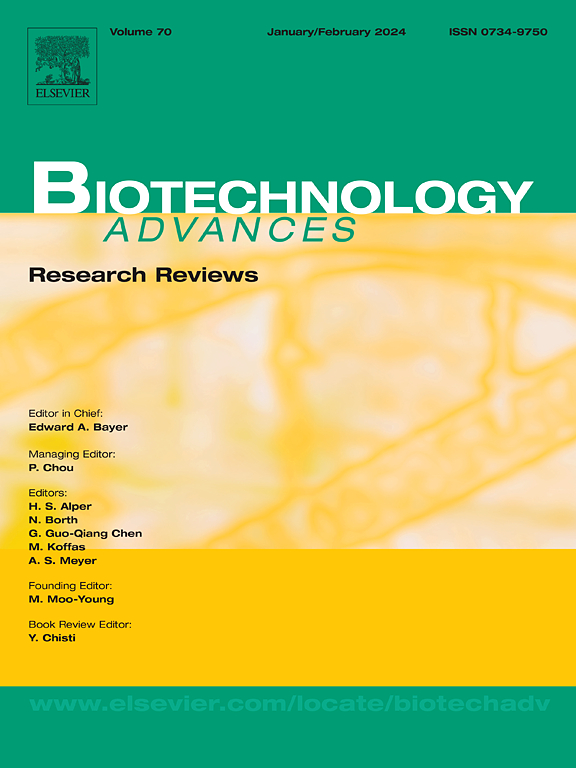植物细胞壁生物合成:免疫信号、基因组编辑和生物量增值的生理意义。
IF 12.5
1区 工程技术
Q1 BIOTECHNOLOGY & APPLIED MICROBIOLOGY
引用次数: 0
摘要
植物不断面临着来自病原体、害虫和环境挑战的生物压力,威胁着它们的生存和生产力。作为回应,植物已经发展出复杂的免疫系统,细胞壁在防御中起着核心作用。植物细胞壁不仅提供机械强度,而且作为对抗病原体的动态屏障,影响植物生长和免疫反应。本文综述了多组学技术促进细胞壁生物合成的分子机制,特别是木质素和其他多糖的合成和调控,它们对细胞壁完整性和植物免疫有重要作用。它探讨了细胞壁修饰和免疫信号通路之间的相互作用,突出了模式识别受体在病原体检测和防御激活中的作用。此外,还讨论了基因组编辑,特别是CRISPR-Cas在增强细胞壁特性以提高病原体抗性和生物量利用方面的潜力。随着人们对木质纤维素生物质作为生物燃料和生物产品的可再生资源的兴趣日益增加,本综述还讨论了生物质难降解的挑战,重点介绍了提高糖化效率的生物技术进展。最后,本文提出了结合基因改造、生物技术创新和可持续实践的综合战略,以优化木质纤维素生物质,促进生物经济,促进农业恢复力和可持续能源生产。随着气候变化的加速,这些技术有望培育出具有抗逆性的作物,并增强生物经济减轻环境影响的能力。本文章由计算机程序翻译,如有差异,请以英文原文为准。
Plant cell wall biosynthesis: Immune signaling, genome editing, and physiological implications for biomass valorization
Plants continuously face biotic stress from pathogens, pests, and environmental challenges that threaten their survival and productivity. In response, plants have developed complex immune systems, with the cell wall playing a central role in defense. The plant cell wall not only provides mechanical strength but also acts as a dynamic barrier against pathogens, influencing both plant growth and immune responses. This review discusses the molecular mechanisms of cell wall biosynthesis, facilitated by multi-omics technologies, particularly the synthesis and regulation of lignin and other polysaccharides, which contribute to cell wall integrity and plant immunity. It explores the interplay between cell wall modifications and immune signaling pathways, highlighting the role of pattern recognition receptors in pathogen detection and defense activation. Additionally, the potential of genome editing, especially CRISPR-Cas, in enhancing cell wall characteristics to improve pathogen resistance and biomass utilization is discussed. With growing interest in lignocellulosic biomass as a renewable resource for biofuels and bioproducts, this review also addresses the challenges of biomass recalcitrance, focusing on biotechnological advancements to improve saccharification efficiency. Finally, the review proposes integrated strategies combining genetic modifications, biotechnological innovations, and sustainable practices to optimize lignocellulosic biomass for a bio-based economy, contributing to both agricultural resilience and sustainable energy production. As climate change accelerates, these technologies hold the promise of developing resilient crops and enhancing the capacity of the bioeconomy to mitigate environmental impacts.
求助全文
通过发布文献求助,成功后即可免费获取论文全文。
去求助
来源期刊

Biotechnology advances
工程技术-生物工程与应用微生物
CiteScore
25.50
自引率
2.50%
发文量
167
审稿时长
37 days
期刊介绍:
Biotechnology Advances is a comprehensive review journal that covers all aspects of the multidisciplinary field of biotechnology. The journal focuses on biotechnology principles and their applications in various industries, agriculture, medicine, environmental concerns, and regulatory issues. It publishes authoritative articles that highlight current developments and future trends in the field of biotechnology. The journal invites submissions of manuscripts that are relevant and appropriate. It targets a wide audience, including scientists, engineers, students, instructors, researchers, practitioners, managers, governments, and other stakeholders in the field. Additionally, special issues are published based on selected presentations from recent relevant conferences in collaboration with the organizations hosting those conferences.
 求助内容:
求助内容: 应助结果提醒方式:
应助结果提醒方式:


